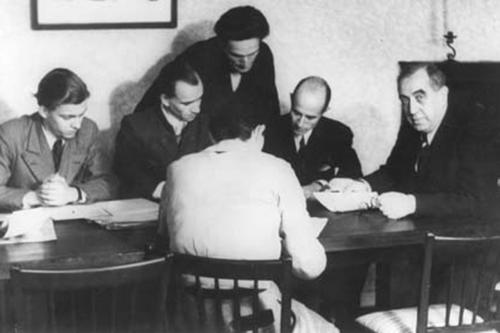From Stopgap Solution to Established Institution
Meeting of the chairperson of the board of trustees of Freie Universität, Lord Mayor Ernst Reuter, with the curator, F. Bergmann, and members of the student council, D. Spangenberg, G. Grinke, D. Knust, and H. Coper.
Image Credit: Freie Universität Berlin, Universitätsarchiv
In the 1950s, Freie Universität developed into a university with an international reputation. Top names were appointed as professors, many of them returning after having fled from the Nazis, and numerous new institutes were created.
This expansion was financed by funds from the budgets of Berlin and the German Federal Government, and with grants from the United States. By 1967, Freie Universität had received 79.5 million DM in all from U.S. State Department funds and 16.6 million DM from the Henry Ford Foundation. This money was primarily used for a number of new buildings (the Henry Ford Building, the University Library, and the mensa /dining hall) and to found institutes, such as the Institute of Eastern European Studies. In addition, the tutor system, previously unknown in German universities, was introduced, and prominent academics were invited to hold guest lectures.
Within the very first year, the number of students rose from 2,140 to 4,946. About half of these came from West Berlin and a third from East Berlin or East Germany (GDR), with the rest coming from West Germany (BRD) and abroad. For the winter semester 1961-6212, 843 students enrolled at Freie Universität. They took a committed political stand in the 1950s and early 1960s against the influence of former National Socialists in state posts and in society, and also against the Communist dictatorship in the GDR.
Read more:

